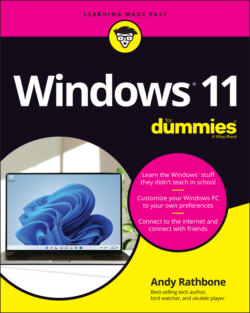Читать книгу Windows 11 For Dummies - Andy Rathbone - Страница 45
Dumpster diving in the Recycle Bin
ОглавлениеThe Recycle Bin, that wastebasket icon in the upper-left corner of your desktop, works much like a real recycle bin. Shown in the margin, it lets you retrieve the discarded desktop files you thought you’d never need.
You can dump something from the desktop or File Explorer — a file or folder, for example — into the Recycle Bin in either of these ways:
Simply right-click the unwanted item and choose Delete from the pop-up menu. Windows asks cautiously if you’re sure that you want to delete the item. Click Yes, and Windows dumps it into the Recycle Bin, just as if you’d dragged it there. Whoosh!
For a quick deletion rush, click the unwanted object and poke your Delete key.
Want something back? Double-click the Recycle Bin icon to see your recently deleted items. Right-click the item you want and choose Restore. The handy little Recycle Bin returns your precious item to the same spot where you deleted it. (You can also resuscitate deleted items by dragging them to your desktop or any other folder; drag ’em back into the Recycle Bin to delete them again.)
The Recycle Bin can get pretty crowded. If you’re searching frantically for a recently deleted file, tell the Recycle Bin to sort everything by the date and time you deleted it: Right-click an empty area inside the Recycle Bin and choose Sort By. Then choose Date Deleted from the pop-up menu.
To delete something permanently, just delete it from inside the Recycle Bin: Click it and press the Delete key. To delete everything in the Recycle Bin, right-click the Recycle Bin icon and choose Empty Recycle Bin.
To bypass the Recycle Bin completely when deleting files, hold down Shift while pressing Delete. Poof! The deleted object disappears, ne’er to be seen again — a handy trick when dealing with sensitive items, such as credit-card numbers or bleary-eyed selfies.
The Recycle Bin serves as an intelligent wastebasket, though. Here are a few other ways it shines:
The Recycle Bin icon changes from an empty wastepaper basket to a full one (as shown in the margin) as soon as it’s holding any deleted file or files.
The Recycle Bin holds only items deleted from the desktop, and your files and folders. It doesn’t retain information deleted from apps or programs.
Your Recycle Bin keeps your deleted files until the garbage consumes about 5 percent of your computer’s available space. Then it automatically purges your oldest deleted files to make room for the new. If you’re low on hard drive space, shrink the bin’s size by right-clicking the Recycle Bin and choosing Properties. Decrease the Custom Size number to purge the bin more quickly; increase the number, and the Recycle Bin hangs onto files a little longer.
The Recycle Bin saves only items deleted from your computer’s own drives. That means it won’t save anything deleted from a memory card, phone, MP3 player, flash drive, or digital camera.
Already emptied the Recycle Bin? You might still be able to retrieve the then-trashed-now-treasured item from the Windows File History backup, covered in Chapter 13.
If you delete something from somebody else’s computer over a network, it can’t be retrieved. The Recycle Bin holds only items deleted from your own computer, not somebody else’s computer. (For some awful reason, the Recycle Bin on the other person’s computer doesn’t save the item either.) Be careful, and make sure every computer in your house has a backup system in place.
